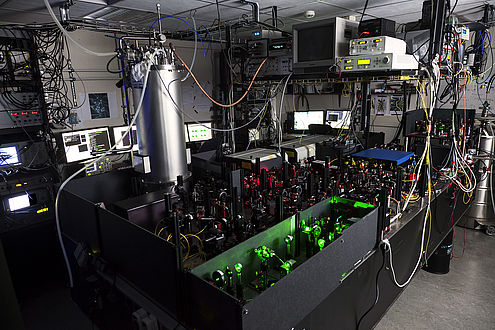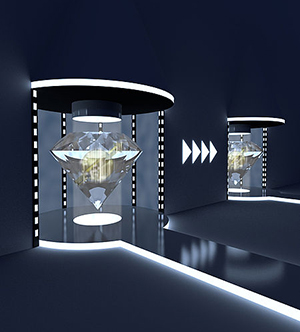29 May 2014
by Webredactie M&C
Teleporting people through space, as is done in Star Trek, is impossible by the laws of physics. Teleporting information is another matter, however, thanks to the extraordinary world of quantum mechanics. Researchers at TU Delft's Kavli Institute of Nanoscience have succeeded in deterministically transferring the information contained in a quantum bit – the quantum analogue of a classical bit - to a different quantum bit 3 metres away, without the information having travelled through the intervening space: teleportation. The results have been published online in Science, on Thursday 29 May.
Quantum internet
This development is an important step towards a quantum network for communication between future ultra-fast quantum computers – a quantum internet. Quantum computers will be able to solve certain important problems that even today's supercomputers are unable to tackle. Furthermore, a quantum internet will enable completely secure information transfer, as surreptitious eavesdropping will be fundamentally impossible in such a network.
Einstein
To achieve teleportation the scientists made use of an unusual phenomenon: entanglement. ‘Entanglement is arguably the strangest and most intriguing consequence of the laws of quantum mechanics,’ argues the head of the research project, Prof. Ronald Hanson. ‘When two particles become entangled, their identities merge: their collective state is precisely determined but the individual identity of each of the particles has disappeared. The entangled particles behave as one, even when separated by a large distance. The distance in our tests was three metres, but in theory the particles could be on either side of the universe. Einstein didn't believe in this prediction and called it ‘spooky action at a distance’. Numerous experiments, on the other hand, agree with the existence of entanglement.

100%
Hanson's research group is the first to have succeeded in teleporting information between qubits in different computer chips. ‘The unique thing about our method is that the teleportation is guaranteed to work 100%. The information will always reach its destination, so to speak. And, moreover, the method also has the potential of being 100% accurate,’ says Hanson.
Diamonds
Hanson's research group produces qubits using electrons in diamonds. ‘We use diamonds because ‘mini prisons’ for electrons are formed in this material whenever a nitrogen atom is located in the position of one of the carbon atoms. The fact that we're able to view these miniature prisons individually makes it possible for us to study and verify an individual electron and even a single atomic nucleus. We're able to set the spin (rotational direction) of these particles in a predetermined state, verify this spin and subsequently read out the data. We do all this in a material that can be used to make chips out of. This is important as many believe that only chip-based systems can be scaled up to a practical technology,’ explains Hanson.
Holy Grail
Hanson is planning to repeat the experiment this summer over a distance of 1300 metres, with chips located in various buildings on TU Delft's campus. This experiment could be the first that meets the criteria of the 'loophole-free Bell test', and could provide the ultimate evidence to disprove Einstein’s rejection of entanglement. Various research groups, including Hanson's, are currently striving to be the first to realise a loophole-free Bell test, which is considered 'Holy Grail' within quantum mechanics.
Publication:
Science, published online May 29 2014
‘Unconditional quantum teleportation between distant solid-state quantum bits’
Authors: W. Pfaff1, B. Hensen1, H. Bernien1, S.B. van Dam1, M.S. Blok1, T.H. Taminiau1, M.J. Tiggelman1, R.N. Schouten1, M. Markham2, D.J. Twitchen2, and R. Hanson1
1Kavli Institute of Nanoscience Delft, Delft University of Technology, P.O. Box 5046, 2600 GA Delft, The Netherlands
2Element Six, Ltd., Kings Ride Park, Ascot, Berkshire SL5 8BP, United Kingdom
We acknowledge support from the Dutch Organization for Fundamental Research on Matter (FOM), the DARPA QuASAR program, the EU DIAMANT and S3NANO programs, a Marie Curie Intra-European Fellowship and the European Research Council through a Starting Grant.















